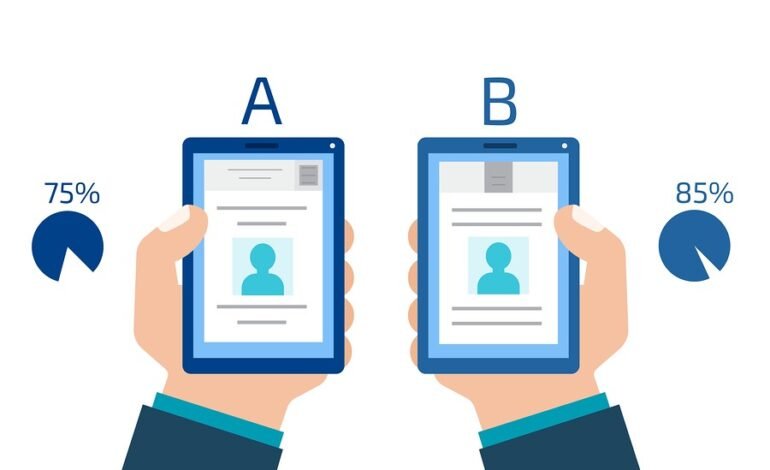What is A/B testing?

Hello, you’re here again! Delighted to meet you again. 🙂
If you want to optimize your marketing and make the most of every last drop of your budget, A/B testing is your secret weapon. It is a very simple methodology to implement; it only requires a little organization, perseverance, and discipline. And thanks to them, you can improve every element of your marketing campaigns until you are sure that you are publishing the most appropriate content at the perfect time.
A/B testing is an opportunity you can’t miss. So today we are going to see what exactly these tests consist of, how and why to launch them, what to do, and what not to do, and a success story of an application. Let’s go for it!
1# What exactly is an A/B test?
A/B testing simply consists of testing two variants of some element of our marketing, comparing how they work to draw conclusions and apply the results. Although it can be used with all types of content, it is generally more popular when designing and launching email campaigns and landing pages.
The process is very simple: we create two versions of the same content that only vary in one element, we launch both at the same time, and we check which one works best by looking at the metrics after a certain amount of time. The goal is to identify small, actionable changes that we can apply to our marketing to achieve better results each time.
1.1# 7 reasons to A/B test
- To increase your profitability. A/B testing is one of the most affordable and easiest ways to increase your ROI in no time. Thanks to them, you can get information about what things really work when it comes to increasing your conversion. This way, you can incorporate the changes into your new campaigns from the beginning and refine them to make them more and more effective.
- To innovate without losing your mind. Marketers know that you have to renew or die, but jumping into the void without a net usually ends badly. Having a solid A/B testing strategy in place will help you incorporate changes in a controlled and measurable way and stick with only what works for your brand.
- To improve your credibility. There are different elements that you can incorporate into your content to show users that you are trustworthy. It can be a seal of trust from an official institution, a reference to the people behind your company, a testimonial… The thing is, different tests work better with different audiences, so A/B testing will allow you to identify the ones that really matter to your audience.
- To always get the copyright. Copywriting is a very artful process, but systematic testing will allow you to give it a scientific approach. Don’t just experiment with the title of a landing page or the subject line of an email: try different lengths of text, sales pitches, or even tone.
- To take care of the details that count. Something as simple as the color of a call-to-action button or the size of an image can make a crucial difference in your conversions. With proper testing, you will be able to identify and apply the details that make your sales skyrocket.
- To know your audience. No two brands are the same… and therefore, no two audiences are the same. The only way to really know your target audience is to do experiments. Little by little, you will find a way to win their heart and improve your results and your brand image.
- To build customer loyalty. Finally, remember that A/B tests are not only used to achieve a first conversion, but you can also apply them to your loyalty strategy. Optimize your marketing to get them to stay with you forever!
1.2# How to A/B test with Google Analytics
“I’m already convinced. And now?” There are plenty of A/B testing tools on the market, so you’re sure to find one that suits your needs. To get started, let’s look at how to use this type of testing to improve your conversion with Google Analytics.
Thanks to the Content > Experiments section of this tool, you will be able to carry out A/B tests on your website without complicating your existence too much. Here are the steps to follow:
- Define your experiment: Decide which page you want to test and which is the first element you’re going to modify. Generally, the easy way to create the two versions of the page is to make a duplicate and change only the element you want to test. You can compare a working page and a new version, or create a page with two variants from scratch.
- Set your experiment options. In Google Analytics, you can configure several aspects of your test: the goal, the percentage of visitors included in the experiment, the time it will be active, and even the confidence level of the results.
- Ready to launch. When you publish your experiment, users will see one of the two alternatives, randomly allocated. The visitor will never know that they are part of a test. If you visit the page again and have the cookie in your browser, you will always be shown the same version.
- Analyze the results. As visits occur, Analytics will store the results. When you’re ready, you can check the metrics for both versions and see which one works best. From here, you can make your decision about which item to change or keep… and go on to test the next one.
1.3# Do’s and Don’ts in an A/B Test
To ensure maximum results, we recommend that you take into account these best practices:
- Change only one item at a time. When we start doing these tests, sometimes we are in a hurry and we want to check everything. But creating completely different variants is a mistake, as you won’t know what worked each time. So it’s better to focus and check a single element on each occasion: the size of the button, the copy, the color…
- Look at your key KPIs. There is no point in measuring clicks if what we want is to increase the sales of a certain product, for example. A/B testing should always be in line with your marketing goals and compare the metrics that are most related to them, for example, the conversion of new visitors or repeat purchases.
- Incorporate the results. After the experiment, it’s time to take action! The goal of A/B testing should always be to find actionable changes that you can implement now. So incorporate the winning detail and keep testing the next variable until you get the perfect landing page (or email, or ad…).
And so you don’t get your fingers caught, avoid these mistakes:
- Compare apples and oranges. The groups of users on whom the test is carried out have to be as homogeneous as possible, or the results will not be reliable. So it’s not worth targeting each variant to visitors who come from a different channel or who have some other important difference.
- Let yourself be carried away by impatience. For the results of an experiment to be statistically relevant, they must be done over as large a group as possible. If your website doesn’t have a lot of traffic, that means you should leave both variants active for days or even weeks to get truly reliable data.
- Do not risk. The A/B tests are the perfect place to unleash your creativity and experiment. Dare to try your craziest ideas, you never know what can give you a surprise in the results!
2. Case study: How to get the maximum return with Social Ads images
Finally, I’d like to share with you a success story in which A/B testing is used to run more effective social media advertising campaigns.
- Images in Social Ads: how to get the maximum return
Given the immense amount of content that is posted on social media every day, getting users to click on our ad can be quite a challenge. And for this, it is essential to stand out with an image that attracts the user’s attention.
For our test, we launched a series of Social Ads whose images responded to two variants: one followed the brand’s style guide, while the other was created with a 100% performance approach. The second image met the following characteristics:
- Use strong contrasts and bright colors, which stand out against the environment of the networks (such as red, orange, or yellow).
- Do not abuse the filters, as they attenuate the strength of the image.
- Ensure readability and control the overlapping of visual elements, logos, and text.
- Include discounts and discounted prices as part of the image, not just in the copy.
The result: performance-focused images saw 35% more CTR and more than double the ROI in terms of sales and revenue. And now, when we recommend them to our customers, we do so knowing that they work.
I hope you found the article useful and clarified what an A/B test is and how it’s done. See you in future content!










